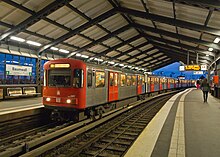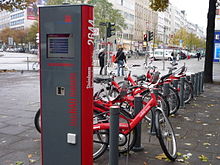Local transport in Hamburg
The transport in Hamburg consists of a rail network ( subway the elevated train , the train of the DB and the so-called A-path of the AKN ) and numerous bus lines of the two transport companies high web and VHH . The tram (the HHA) was discontinued from the 1960s until autumn 1978. There are also HADAG shipping lines and harbor ferries in the port and to the Elbe suburbs ( Finkenwerder , Nienstedten , Blankenese ) .
Local transport is organized by the Hamburger Verkehrsverbund (HVV). There is a uniform network tariff. The "Hamburg AB" (for the season ticket tariff 2 "rings") also includes some neighboring cities and communities in Schleswig-Holstein and Lower Saxony . The network area includes the neighboring districts of Schleswig-Holstein and the districts of Lower Saxony.
Rapid transit systems

The subway network consists of four lines. Particularly noteworthy is the oldest line U3 , which runs in a ring from Barmbek and through the city center (opened in 1912). With its viaduct sections, it establishes the additionally popular designation "elevated railway" (hence the name Hamburger Hochbahn AG ). The tourist attractions include the viaduct routes at the harbor between Rödingsmarkt underground station and Landungsbrücken and between Eppendorfer Baum and Hoheluftbrücke in Harvestehude .
The S-Bahn operates on five radial main lines with the line designations S1, S21, S3 and S31. There are also lines S11 and S2, which reinforce the main lines during rush hour and shop opening hours. The main lines are minute in 10- stroke operated, which is thinned to the outer track portions, and in the night traffic. There is an above-ground connection between the main train station and Hamburg-Altona via Dammtor (connecting train) and a tunnel section via Jungfernstieg and Landungsbrücken ( City-S-Bahn Hamburg ). This is the reason for the two-digit line names: Lines S11, S21 and S31 run over the older connecting line . The S-Bahn railcars are operated with direct current and supplied with power via busbars painted on the side . The exception is the Lower Saxony section from Neugraben to Stade , on which special two-system S-Bahn multiple units can run on the route equipped with overhead lines.
Regional trains are of little importance within the Hamburg metropolitan area, but they can be used with HVV network tickets. The region is opened up with regional transport lines from various railway companies . These lines are named "RE" for RegionalExpress or "RB" for RegionalBahn followed by a line number.
In addition, the state-owned AKN of the states Schleswig-Holstein and Hamburg operates three railway lines (A1 – A3), which are referred to as A-Bahn in the HVV. In terms of tariffs, the A-Bahn is assigned to the express trains, just like the U- and S-Bahn.
Bus transport
The Hamburg public bus network is now divided into different types of bus lines that consolidate the rapid transit network and connect the urban areas with the surrounding area:
- Metrobus lines with one or two-digit line numbers (1–29), which, with certain quality criteria of the frequency of use, form the basic structure of the Hamburg city bus network; also operate in the nights on Saturdays, Sundays and public holidays
- Supplementary “normal” city and regional bus lines with three-digit line numbers
- supplementary charge express bus lines with two-digit numbers line (31-37) connecting the outer with larger distances between stops areas to change trains with downtown
- Surcharge- free " Xpressbus " lines that provide direct connections to rapid transit stations, preferably for commuter traffic (line numbers with a prefixed X)
- Night bus lines (line numbers 600–688), which operate with different frequencies depending on the day of the week (nights on Mondays to Fridays or on Saturdays, Sundays and public holidays) (Mon-Fri also as a replacement for the then non-operating rapid transit lines)
Night traffic
On the nights from Sunday to Thursday, the regular express train and bus service ends around 0:30 a.m. From 1970, from 1:00 a.m., only night bus lines with numbers 600 ran at least every hour from Rathausmarkt in all directions, as well as a half-ring line with number 600. Before that, there were also tram lines that were operated during the night. From transport hubs such as Barmbek or Wandsbek Markt there is a connection to other night bus routes that lead from there to the outskirts.
On the nights before Saturdays, Sundays and public holidays in Hamburg, the underground trains in Hamburg run continuously every 20 minutes, and there is continuous 24-hour operation on many S-Bahn, Metro and city bus routes. Night traffic can be used at the normal tariff free of charge.
History of night traffic
In the 1920s - when trams dominated and a bus and coach network was just developing - Hamburg already had night bus routes. However, the post-war years were the era of the tram. A night tram network was set up, which in addition to diameter lines until 1957 also included a ring line (Alsterring) via St. Pauli contained. In May 1959, line 52 (Altona - Wallring - Hauptbahnhof) was the first night bus line of the post-war period (extension of day line 52). It became necessary after tram lines 6 and 7 between St. Pauli and Altona were closed. In later years the night bus network was expanded when tram lines were discontinued. The night buses had always adopted the name of the day lines, as was the case with the tram. The night network was completely reorganized for the 1970 summer timetable (valid from the end of May), with the last night tram lines being completely discontinued. Since then, the buses with numbers 600 have been going out into the city districts every full hour from Rathausmarkt. The timetables were coordinated in such a way that the buses arrived at Rathausmarkt shortly before the hour, so that the passengers had enough time to change. In the district centers, supplementary lines began (e.g. B. at Bf. Barmbek line 617), which in turn had connection to the most important night lines touching the Rathausmarkt (in this example the 607). This system was completed by the half-ring line 600, which ran every 30 minutes and connected the district centers with one another, but did not offer direct connections to all radial lines. In later years, additional lines were set up, some of which were only operated on the weekend nights. The night bus network was operated in this form until December 2004. Due to the increasing number of passengers, a reorganization of the night network seemed sensible. In the inner week nights, the night bus network will continue to operate as before, with the buses usually running every hour. On the weekend nights, on the other hand, most of the U- and S-Bahn lines are now operated continuously every 20 minutes. (Except for the U1 and the Pinneberger S3 going to Norderstedt Mitte, all rapid transit trains end at the last station in Hamburg.) The continued operation of the previous night bus system with the rapid transit network did not make sense. For this reason, numerous Metrobus and normal bus lines (in some cases adapted or shortened compared to the daily line) are now also operated around the clock at 40-minute intervals that have direct rapid transit connections. Only in a few cases are normal night buses (with number 600) in use on these nights.
In addition, there was a personal bus network operated by the HHA until the 1980s . Their buses ran according to fixed timetables along the underground lines and offered employees a connection to the night bus network. (Example line: Großhansdorf - Barmbek with a stop near all subway stops) After all, every subway stop used to be staffed until after the end of operations and the aim was to offer both employees and train drivers the opportunity to go to work without a car to reach. The ride was free for Hochbahner. There was even a separate timetable booklet. These lines were not mentioned in the normal timetable book, but it was still possible for non-HHA employees to use these buses for a fee. However, this ticket did not entitle you to change trains. Later these driving services were taken over by taxis and since then have really only been reserved for employees of the HHA.
Shipping
Six shipping lines operate on the Elbe and in the port area at the normal HVV tariff. There are also tourist offers on the Lower Elbe and also on the Alster and the adjacent canals. The HVV network tariff was also in effect on the Alsterschiffs lines until 1984, so they performed tasks in local urban transport. After that, the range of scheduled trips was primarily geared towards tourism and leisure activities.
At the traffic junction St. Pauli-Landungsbrücken there are not only the jetties but also the stops of the underground line U3 , the S-Bahn lines S1, S2 and S3 as well as the bus lines 111, 112 and the night bus line 608. Decades ago Tram lines 1, 7 and 14 still run here.
On-demand offers
The VHH and the technology company ioki operated under the name ioki Hamburg an on-demand traffic in some areas of the city , which is intended to complement the existing local traffic. In addition (as of June 2020), MOIA and FREE NOW, two private ridepooling companies, are active in Hamburg.
StadtRAD Hamburg
The StadtRAD bike rental system complements local public transport in the inner city area (around Ring 2) and in Wilhelmsburg . A total of 129 stations and 1,650 bicycles are available at numerous S-Bahn and U-Bahn stations as well as some ferry docks and away from them. Registered users can use their mobile phone, user card or bank card to borrow bikes that can be returned to another station. In terms of usage figures, StadtRAD Hamburg is the most successful bike rental system in Germany, which is confirmed by the top rating in the ADFC bike climate test 2012.
Web links
- Bus acceleration Hamburg (information from the Hamburg Authority for Economics, Transport and Innovation, BWVI)
- Hamburg Transport Association (HVV)
- Hamburger Hochbahn AG (HHA)
- S-Bahn Hamburg
- Hamburg-Holstein Transport Authority (VHH)
- HADAG Seetouristik und Fährdienst AG
- Hamburg local transport archive (historical city and route maps, materials, links)
- via IOKI Hamburg (nahverkehrhamburg.de)
Individual evidence
- ↑ Hamburg city map 1928: tramways.wordpress.com ( Memento of the original from December 8, 2008 in the Internet Archive ) Info: The archive link has been inserted automatically and has not yet been checked. Please check the original and archive link according to the instructions and then remove this notice.
- ↑ Results of the ADFC Bicycle Climate Test 2012, there question 27 ( Memento of the original from February 3, 2013 in the Internet Archive ) Info: The archive link was inserted automatically and has not yet been checked. Please check the original and archive link according to the instructions and then remove this notice.
Remarks



